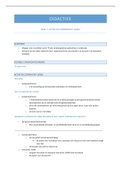Summary
Summary 'Doing Surveys Online' - Vera Toepoel
- Module
- Institution
- Book
An extensive summary of all the chapters of the book "Doing Surveys Online" by Vera Toepoel (2016) (ISBN 978-1-4462-4967-3). This summary can be used to study for the final exam for the course Conducting a Survey at Utrecht University.
[Show more]











